#emu oil
Text
0 notes
Text
Benefits of EMU OIL for Body - Y Not Naturals
The biggest benefit of emu oil is how it absorbs into the skin. Due to its smaller particles, emu oil has increased enhancement and carrier capabilities: It penetrates deeper into your skin and carries other ingredients with it. https://ebay.to/3OEAigJ
0 notes
Text
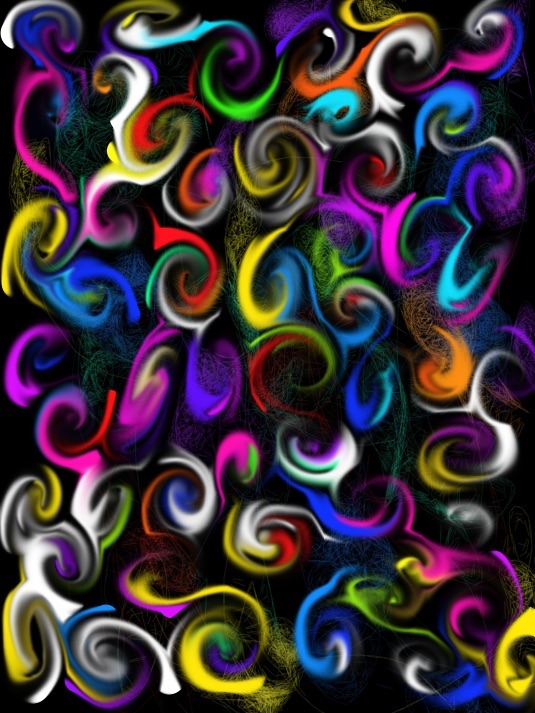
you see this instead of stars
10 notes
·
View notes
Text
reminder to me: I should clean and wax my docs.
#coats chats#they are closing in on a decade old and smooth as fuckin butter by this point#i also need to get them resoled at some point bc the heel is about worn#for those curious I use a brand called oakwood#the leather conditioner contains lanolin beeswax and emu oil#it works a goddamn treat would rec if you can find it#technically its mostly for horse tack? like feed stores carry it shoe stores mostly don't#(also zero idea how common emu oil is as an ingredient overseas. i sort of assume less common.#but??)
3 notes
·
View notes
Text
Fed, clean, moisturized and hydrated so let's have some fun!!

#no aloe#but emu oil and that works well too#so we're sitting here being chill#trying not to be cold tho lol
0 notes
Text
🤚
1 note
·
View note
Text
I love people dunking on Ji/lly Juice.
I just can't help but think "this is how you completely botch making kimchi or sauerkraut." :I
#i haaate snake oil shit like this#it was a near certainty that she made the last days of some guy w/ the big c EVEN WORSE#'cause news flash nobody needs THAT much salt in their system#hypernatremia will /absolutely/ fuck you up#(just thinking about that case report chubby emu covered on a lady who did the soy sauce colon cleanse)#(because when she was desperate to find help for what turned out to be years of untreated/undx'd celiac disease)#(this colon cleanse did permanent damage to her brain - as in presumed locked-in syndrome)#(don't get me started on people torturing their autistic kids with this garbage)
0 notes
Text

The Biology and Riding of Thoma
Thoma, also known as Thomases (singular: Thomas), are the primary animal used on No Man's Land for transportation, meat, eggs, feathers and oil. The meat can be eaten fresh or dried into jerky, and thoma meat, fried in thoma oil and sprinkled with worm dust, is a popular street food. These massive birds were genetically engineered early on in No Man's Land history and are well-suited for the desert, making them easy to raise and care for. Plus, they're easy to ride.
Biology
Thoma are a combination of several bird species, genetically similar to Emu and Ostriches, but with the stature of much larger birds such as the extinct Terror birds (Phorusrhacids), standing near 5-6 feet tall at the withers. Their bright blue plumage and loosely-packed feathers helps dissipate heat. They have long eyelashes to keep out dust, and they have a second eyelid that protect the cornea from grit and bright UV light. This does, however, decrease visibility, making them more prone to tripping over rocks.
Thoma have a long, feathery neck that helps balance them at faster speeds along with the heavy, muscled keel. The keel is engineered to be similar to that of a broiler chicken, as their vestigial wings are useless except for thoma mating displays. Under the throat is a vocal sac, which can be used to transmit low rumbles over long distances. Most thoma, however, prefer to chirp at a frequency easily heard by their human caretakers and riders. They have long, powerful legs, capable of galloping up to 40 iles an hour, and a kick that can disembowel an attacker or rip into a worm's exoskeleton. The three talons on their feet need to be trimmed by an experienced farrier every 4-8 weeks, depending on a bird's mileage.
Thoma eat a diet of seeds, grains, worms, and (when available) fruits and vegetables. Like many birds before them, they will sometimes ingest small rocks and pebbles to help grind their food in the gizzard. The thin, short beak is perfect for pecking at the ground, and when provoked, they will also peck at an enemy. Thoma are, however, generally good-natured creatures, as they have been bred to be.
Riding
Thoma are easy-going and very trainable with a nice floating gait, making them great mounts for humans on No Man's Land. Like many birds, they can move their legs independently from the movement of the spine, which allows the use of saddles. Most saddles are similar to old Western saddles, and are optimized for comfort and long journeys. However, in the bigger cities, some people may ride Thoma in competitions, typically using more English-style tack for greater control of the bird. typically two straps are used to secure the saddle - a breastplate to keep it from sliding back, and a girth/breeching to prevent it from sliding forward. The strong legs are left free to move as needed, giving the bird great flexibility.
The tack on the head often consists of a bridle, a canvas covering on the neck, and a headpiece with blinders. Headpieces and bridles may vary, as the design has been through several different iterations, but the general idea is to generate gentle pressure on the beak when the reins are pulled and to protect the eyes. The headpiece often has blinders and a screen over the eyes, allowing the bird to travel without using the second eyelid. This allows the thomas to move with greater agility, picking its way around desert rocks even at high speeds. The canvas across the neck protects the feathers from the reins and keeps the bird cool. Some headpieces also include a protective metal beak piece that can be used as a weapon.
Thoma make excellent mounts as they are docile, easy to train, have very few natural predators, little fear of humans, and can live on worms alone in a pinch. They do require some water, not having ability to store much themselves, but their ability to dissipate heat and the ways in which the tack can help keep them cool minimizes the need. There are a few wild herds, but most thoma live on ranches or in stables, marked with a leg band or brand.
237 notes
·
View notes
Note
breaks into your inbox
hi, please, sell me on akirui, tell me all about them please. ive been thinking about them after the devil’s manner april fools thing and i just need to hear someone go insane about it i think
uh, yeah!! :]
HELLO. OUGH OUGH OUGH WHERE DO I BEGIN.
first of all the "like oil and water" trust rank title (that ensekai butchered but what doesnt ensekai butcher involving queer ppl lbr)
okay first of all i just think the premise of where their dynamic starts is so funny bc they r so >:3 >:| core and i love that for them.
BUT. goes under the cut bc i have thoughts and feelings
the thing i LOOOVE tapping into with akirui (and akikasa/akiruikasa) as well is that for all akito bitches and moans hes more like rui (and tsukasa) then he insists he isnt.
i made another post before about akito and tsukasa both push themselves beyond their health limits for their dreams (and as well in my fic 'the balsam, fallen silent' it comes up that tsukasa's stunt in phoenix pissed akito off BECAUSE of how much it reminded him of himself with what happened in sbd)
with rui you have to read between the lines a bit more but there's a big deal made of how they're both very passionate about what they create and making what they create the best they can be
similarly to the phoenix/sbd stuff, rui does also push himself in a different but similar way, as seen in darkfes, where akito chastises him for downplaying his injury and to let people help him for the sake of putting on the best show possible.
you could argue there's a point of comparison to be made about how much they mask. akito with his polite front he uses around people he doesn't know, and rui reigning himself in at best or acting completely detached from what hurts him at worst. there's an excerpt from a fic i really like that summarizes rui's state well i think:

(taken from 'summer heat' by cepheide, a very good, 10/10 recommended akirui read from me)
and also as well as of the most recent event, we have rui asking akito who does and doesn't know about the latter's fear of dogs because he's trying to be delicate and careful regarding discussion of what is described to be trauma for akito, and akito is shown to be surprised and very touched by this act.
i don't think akito ever truly fully hated tsukasa or rui, but in the case of rui you can really see how much akito grows to tolerate and enjoy his company, to the point he can enjoy himself in rui's presence so long as rui doesn't try to treat him like tsukasa (ie: the situations)
also if i can ever finish the wip i have w/ them. the topic does come of shinei being a shithead, and i don't think we talk enough about how of the times we've seen rui genuinely pissed off and ready to throwdown it was about someone harming (emotionally or otherwise) a person he cares about. rui would hear about shinei and experience a rage unlike anything he's experienced since the scuffles with shosuke emus brothers. ive said this before but if akitoya is "lets run away together and we can escape everything and everyone thats ever hurt us", akirui is "you can run to me, i'll protect you. i won't let anyone hurt you ever again"
74 notes
·
View notes
Link

#emu oil#emu#australian emu oil#pure emu oil#emuoil#emuoilcapsules#buy natural emu oil pet shampoo#buyemuoilshampoo#100% pure organic#100%pureaustralian
0 notes
Text


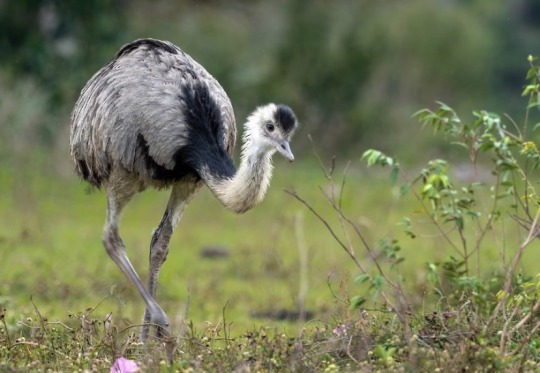
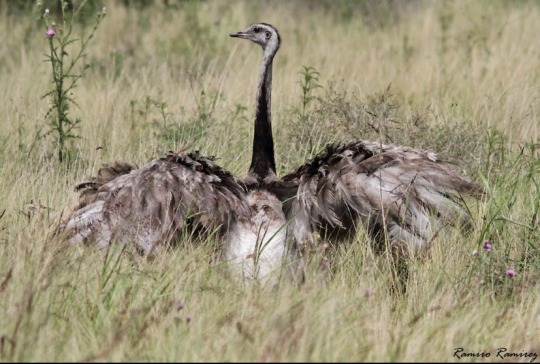



the greater rhea is a large ratite (member of the same family as ostriches and emus) native to eastern portions of south america. they are the largest bird native to the americas, at just below five feet in height, weighing up to 60 lbs. they have also established a feral population in germany, surpassing 500 birds as of 2018. as domestic animals, the rhea has been known to serve many purposes for humans - meat, eggs, leather, and even rhea oil, used for cosmetics. these birds are largely fearless, which can make them vulnerable to introduced predators. they often travel in flocks of 10-100 when not in the breeding season. they are entirely flightless. the rhea is polygamous, and eggs are incubated en masse in shared nests, sometimes reaching 80 eggs to a nest.
#greater rhea#rhea#bird#birblr#ratite#finally. the moment you’ve all been waiting for. it’s rhea time
834 notes
·
View notes
Text
Wet Beast Wednesday: emperor penguin
This is the last Wet Beast Wednesday before Christmas and Christmas is associated with the north pole thanks to Santa. So to celebrate the season, I'm going about as far away from the north pole as it is possible to go and talking about the emperor penguin. This also happens to be the first dinosaur I've showcased on this series.
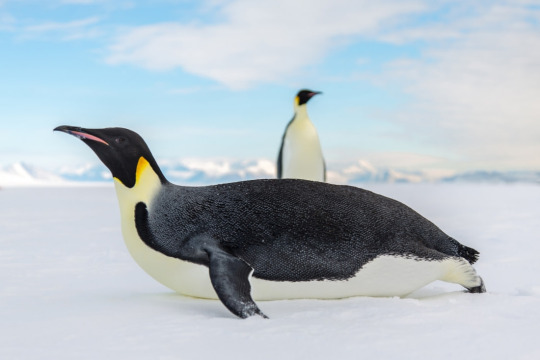
(image id: an emperor penguin lying belly-down on ice, seen from the side. Its back, wings, and head are black while its belly and neck are white. It has a patch of orange feathers near the ears. Another penguin is standing up in the background. end id)
Aptenodytes forsteri is the largest of all penguins and the sixth largest (by weight) bird in the world, only surpassed by the emu and two species each of the cassowary and ostrich. Those are all paleognaths, one of two living groups of birds, making the emperor penguin the largest of the other group: the neognaths. There are some discrepancies on their size due to the standards of bird measurement, but recent measurements list their standing height as reaching 120 cm (3.9 ft) with a weight of 22.7 to 45.4 kg (50 to 100 lbs). Their weight varies a lot during their lives, with both males and females losing a lot of weight during breeding season. Males generally weigh more than females. Genomic and anatomical analysis indicates that the emperor penguin, along with the closely-related king penguin and an extinct species, are part of a group of penguins that branched off of the family tree before the other living penguin species. As with other penguin species, they are heavily adapted for life in the water. All penguins are flightless, with their wings having adapted into flippers used for swimming. Penguins stand differently than other birds. Most birds have long legs and hold their bodies horizontally to the ground or at an angle, but penguins have short legs and hold their bodies vertically, like humans do. This, plus other adaptations, helps streamline the birds, letting them swim more efficiently. Like other seabirds, their feathers are very dense and coated with oil that repels water. This keeps the feathers from becoming waterlogged, reducing drag and helping keep the bird warm. During molting season, the feathers emerge from the skin mostly formed and push out the old feathers, preventing the penguin from developing bald or thin patched that would compromise insulation. While the feathers are responsible for most of the insulation, a layer of fat also helps. Like other birds, penguins are endothermic, commonly known as warm-blooded. Penguin tongues have backward-pointing barbs that help prevent food from escaping their mouths.

(image id: an emperor penguin jumping out of the water and onto ice. It is pictured in midair with its body roughly parallel to the ground and wings extended. Multiple other penguins are in the background. end id)
Emperor penguin's divide their year between the breeding season and the rest of their lives. During most of the year, they spend their time searching for food. Most of this food consists of fish, krill, and squid. Emperor penguins are social animals that often coordinate with each other to hunt in groups. While hunting, they will dive up to 535 meters (1,755 ft) and spend up to 21 minutes underwater before surfacing to breathe. During dives, the pressure can increase up to 40 times and the emperor penguin has some special adaptations to cope. Unlike most birds, emperor penguin bones are solid, reducing the chance of one breaking under pressure. During dives, the heartbeat slows dramatically and non-essential organs cease functioning to conserve oxygen in the blood. In addition, the hemoglobin in the red blood cells is modified to carry more oxygen in high pressure and low temperature. While on land, emperor penguins gather in colonies along the shoreline. Members of the colonies spend a lot of them time huddled against each other to keep warm. The penguins live all around Antarctica between 66 and 77 degrees southern latitude.
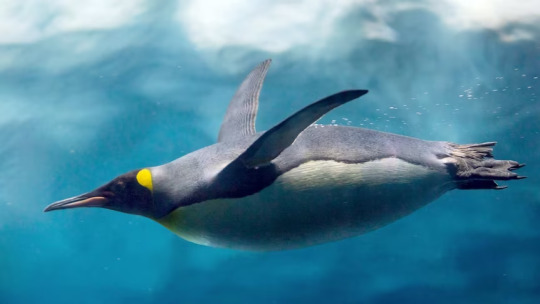
(image: an emperor penguin swimming underwater. Its head is pointed up, making its body very streamlines. Its wings are extended and are used for propulsion and steering. end id)
The thing emperor penguins are most famous for is their breeding behavior. Breeding season starts at the beginning of winter in Antarctica, between March and April, and is triggered by the decrease in day length. Penguin colonies travel inland en masse moving between 50 and 120 km (31 to 75 miles) to find a spot to raise their chicks. These spots are usually large, flat patches of sea or lake ice with a barrier such as a cliff or iceberg used to block the wind. Males perform sexual displays wherein they make loud courtship calls while wandering around the colony. When a female is interested, she will face they male and they will both hold their heads up for a few minutes. Once a pair os formed, they will walk around the colony together. When ready to mate, The pair will bow to each other. Emperor penguins are serially monogamous. They will only mate with one other penguin each season, but rarely pick the same mate more than once. The pair say together until the egg is laid in late May or early June. The female then transfers the egg (only one is laid every year) to the male, a tricky process. They have to use their feet to transfer the egg without dropping it. If the egg breaks or is exposed to the ice for more than a minute or so, it will die. It is not uncommon for an egg to be lost, especially in first-time parents. If this happens, both parents will leave the colony and return to the sea, not mating again until next year. The male balances the egg on his feet and covers it with a loose flap of skin. The bottom of this skin is a featherless patch called the brood patch that only forms during this season. By keeping the egg between his feet and the brood patch, the male incubates it. Once the egg is transferred, the female returns to the sea, leaving the male responsible for the next few months. In every other penguin species, the mother and father take turns incubating their egg. for the next 65-75 days, the male will incubate the egg in the middle of the Antarctic winter, where storms are frequent and temperatures can can reach into the -60s C (-70s F). He will not eat at all during this period, which, including travel and mating time, can last for 120 days. Males can lose up to half of their body mass during this fast. If the egg is dropped even once, it has a very high chance of dying. Walking without dropping the egg is tricky, but the males will form tight bunches to conserve body heat. These bunches are mobile, with members to the outside gradually moving inward and vice-versa. The egg usually hatches after around 60 days and it can take a few days to break out of its shell, which is thicker than in most bird species. The chicks are born featherless and will freeze to death if they leave the male's brood pouch. The male produces a substance called crop milk with a gland in his esophagus. Crop milk is unique to pigeons, flamingos, and male emperor penguins and is used to feed the chick. The crop milk does not provide full nourishment to the chick, but will keep it alive for about a week.
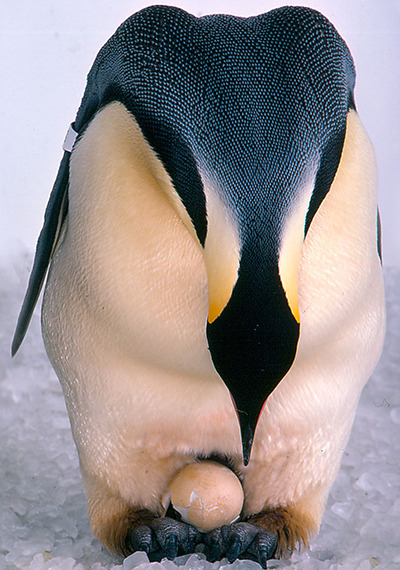
(image id: a male emperor penguin standing on ice with its egg balanced on its feet. The skin flap thet normally covers the egg is pulled back and the male is bending over to examine the egg. This egg is broken, possibly the result of being dropped, and is non-viable. end id)

(image id: a newly-hatched emperor penguin sitting on it's father's feet. It is very small and featherless, with grey skin and a black head. end id)
About this time, the female will return from her time at sea. She spent this time feeding and fattening herself up for the next leg of the parenting journey. She returns to the colony usually between 5 and 10 days after the hatching. If she arrives too late, the chick will starve. Once she arrives, she will locate her mate through the sound of his calls. The male then transfers the chick to the female's brood pouch and returns to the sea to feed and put weight on for another 3-4 weeks. The female will feed the chick by regurgitating half-digested food into its mouth. After this, the mother and father will take turns brooding the chick and feeding at sea. If either parent is delayed or dies, the chick will die as the remaining parent will eventually abandon it and return to sea. Orphaned chicks will try to seek food and shelter from other adults and mothers who have lost a chick may try to adopt an abandoned one, but as a single parent cannot raise a chick alone, it will eventually be abandoned as the adult goes to feed. Sometimes, a mother who lost her chick will attempt to steal a chick from another mother. This leads to fights over chicks that may leave chick trampled to death.
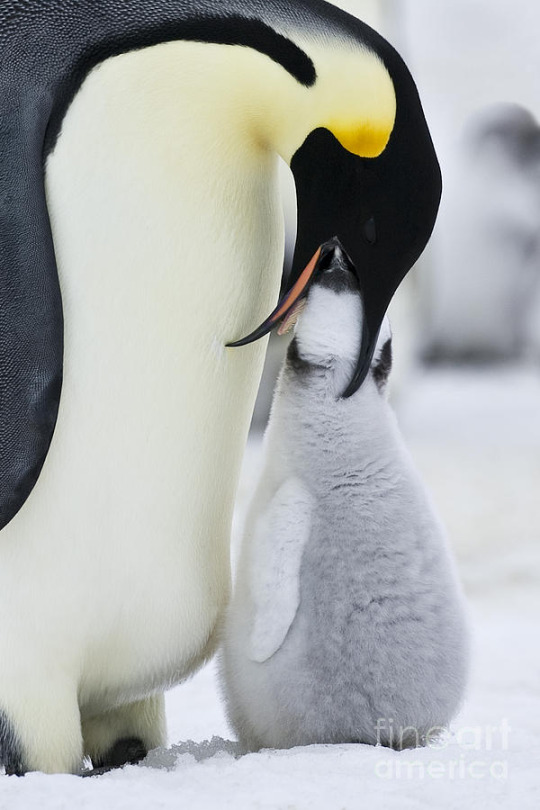
(image id: an adult emperor penguin feeding its chick. The chick is larger and covered in fluffy, grey, downy feathers. It no longer needs to stay on its parent's feet. The adult is looking down at the chick with its mouth open. The chick has its head inside the adult's mouth. end id)
Starting 45-50 days after hatching, the chicks now have a thick enough coat of down to survive outside of the brood pouch. Starting around this time, both parents will return to the sea and occasionally return to bring food, using the sound of their chick's vocalizations to track them down. When the parents are gone, the chick huddle together for warmth. Starting in early November, the chicks will start gaining their adult plumage and the adults will stop returning to feed them. Once they get hungry enough, the chicks will make the trip to the sea (which is shorter now as it is summer in the Antarctic and the sea ice has receded) and will be independent from now on. Only 15% of chicks survive their first year, but after that the survival rate is 95%, meaning most living emperor penguins are adults. Emperor penguins reach sexual maturity at 3 years, but most do not mate until they are 4-6 years old. The average lifespan of those who live long enough to reach adulthood is 20 years, but may live up to 50 years. The high survival rate of adults is in part due to a lack of predators. Adult emperor penguins are only hunted by leopard seals and orcas, though the former prefer juveniles. Juveniles are preyed upon by seals when they reach the water and by southern great petrels when on the ice. Adult emperor penguins lack any land predators, which has resulted in them having no prey response when on land. Scientists and antarctic explorers have reported that adults will approach them without fear.
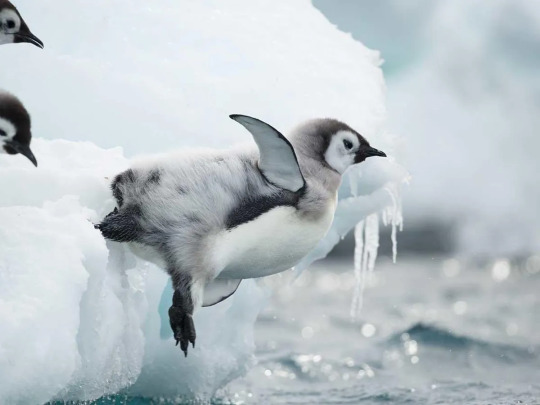
(image id: a newly-independent chick entering the water for the first time. It has not yet fully developed its adult plumage and has a mix of the chick's fluffy down and an adult's smoother coat. It is jumping off a ledge of ice into the water. Two other chicks watch from the side of the image. end id)
Emperor penguins are classified as near threatened by the IUCN, meaning they are losing population and may slip down into threatened status if conservation measures are not taken. The largest threat to emperor penguins is global warming reducing their habitat. Because they need sea ice to lay eggs and brood, the loss of sea ice every year has reduced the ability of the penguins to reproduce. in 2022, loss of sea ice led to a catastrophic failure to reproduce among nearly all known colonies. It is now estimated that 90% of colonies are at risk of dying out due to the loss of sea ice. If these trends are not reverted by reduction of global warming, the penguins could face extinction.

(Image id: two emperor penguins with their chick. The adults are standing behind the chick, which has its downy juvenile plumage. The chick stands about half the height of the parents. end id)
#wet beast wednesday#emperor penguin#penguin#marine biology#biology#zoology#ecology#animal facts#marine life#good parenting#cute#image description
118 notes
·
View notes
Text
wxs living together
wxs living together is tsukasa and nene coming home after a long day of acting and collapsing on the couch on top of each other, with tsukasa giving a mumbled protest and nene telling him to shut up, to which he does, because he's just so tired and cannot muster up the energy to actually shoot something back.
wxs living together is tsukasa chiding his fellow roommates for their habits that tick him off, like rui leaving the cap of the toothpaste off after using it, emu not keeping her shoes on the rack, and nene leaving that one fork or glass in the sink.
wxs living together is emu and tsukasa designing a chore schedule, which they keep on the fridge with magnets. it's nene complying whilst knowing that writing up such a thing is pointless (hell, it'll be gone within a week) when the four of them are under the same roof.
wxs living together is emu bringing home an entire cake for absolutely no reason other than the fact that she wanted to share a cake with her best friends, and then the four of them eating its leftovers for breakfast the next morning despite tsukasa's scolding.
wxs living together is tsukasa coming home very late one night to rui passed out over various blueprints, his pen falling out of his grip. it's tsukasa muttering to himself, fondly exasperated, as he cleans up their shared area and then shortly waking him up with a hushed whisper and leading a very dazed rui to sleep in his bed instead of on a desk.
wxs living together is rui and nene sitting in comfortable silence in the kitchen together at 3 am with hot mugs of tea in their hands when sleep is not in their favour.
wxs living together is emu and nene sharing a room with two separate beds, but emu finding her way to nene's anyway because her bed just feels a bit too empty and well, there's enough space on nene's to spare.
wxs living together is tsukasa leaving his shared room with rui at the crack of dawn to make breakfast because he did not get a wink of sleep and there's a specific recipe he discovered that he is itching to try a hand at. it's emu soon following after in high spirits, peering over tsukasa's shoulder on tip toes to see what he's cooking. it's nene and rui stumbling out of their rooms an hour or more later while the table is being set, yawning and sleep still heavy in their eyes.
wxs living together is "i love you" being exchanged ever so naturally, over goodbyes at the front door, conversations through the phone, the cracking of eggs over sizzling oil, offerings of sweet treats bought from the store across the street, stirring more than one mug of tea and kisses atop heads as the moon rises and the night grows cold.
but they're together, so they cannot help but feel so, so warm.
#jay does a think#project sekai#project sekai headcanons#character thoughts#wxs#wonderlands x showtime#tenma tsukasa#ootori emu#kusanagi nene#kamishiro rui#this is like. purely platonic#please do NOT tag as ship!#sorry im feeling a little sentimental about these sillies#waahh wxs friendship
91 notes
·
View notes
Text
Birds of Maglor’s Gap and Lothlann
This completes my series on birds of the Fëanorian realms pre Amon Ereb!!
March of Maedhros, Himlad, Thargelion, Estolad
Flora, Fauna, geography and environment of Arda Masterlist
Maglor’s Gap was the widest break in the mountains and cliffs dividing Beleriand and the lands to the north. It lay between the blue mountains to the east and the March of Maedhros to the west. Lothlann was a wide expanse of plains to the north of the Gap. The rivers greater and little Gelion ran around the western and eastern borders.
Steppes and plains: Daurian, see see partridge, yellowhammer, black grouse, grey necked bunting, great rosefinch, imperial Eagle, steppe eagle, golden eagle, Mongolian ground jay (rare), greater short toed lark, upland buzzard, Pallas’s sandgrouse, laughing dove, great bustard, bush quail, gray, black and painted francolin, snowcock, little bustard, merlin, cheer pheasant, crested lark, painted sandgrouse, scrubfowl, common quail, brown accentor, ring necked pheasant, grey partridge, black bellied sandgrouse, common buzzard, black kite
By greater and little Gelion (stream/river): black faced bunting, Pallas’s bunting, pin tailed sandgrouse (summer only), white throated dipper, brown dipper, common kingfisher, hobby, swamphen
World building notes
--Laughing doves appear on the sigil of some of Maglor’s host who are particularly skilled in the use of song in battle
-Many of Maglor’s cavalry hunt or fight with birds including golden, steppe and imperial eagles.
-Game birds of the prairie steppes such as partridge make up much of the meat that the cavalry and scouts eat, along with hares.
-Most of the cavalry have horse hair plumes but some of the lieutenants and generals have feathers from pheasants or eagles.
-Emu are actually domesticated in some parts of the world and I love the idea of them being kept in both the Gap and Himlad as well as by peoples East of the Ered Luin. They have a huge variety of uses including leather, oil, eggs and meat. And the chicks are very cute 💙
-I am a huge proponent of prehistoric and extinct animals living throughout Arda, as per Tolkien’s comments about “all creatures which walk or have walked the earth”. I really like the idea of small brush moas living near the mountain borders of the Gap
27 notes
·
View notes
Text
Pro.Sekai as out of context quotes from my friends

———
Mizuki: “Sometimes I feel like a bamboo toothbrush wrapped in plastic.”
———
An: (To Akito) “You look like a tax evader.”
———
Nene: “Yes, I’m laying down for a rest because everyone is dead,”
———
Tsukasa: (To Emu) “Would you like to eat Santa?”
———
Emu: “I was kidnapped, yay!”
———
Ena: “Stop being gay and pet my cat.”
———
Akito: “Oh my god, I didn’t know you could grow a tent!”
———
Emu: “Is there something in my hair?… No, doesn’t taste like it.”
———
Tsukasa: “What the fuck is Arabia?!”
———
An: “Abortion, please!”
———
Mafuyu (or Kanade): “… After I process my emotions for 18 hours.”
———
Airi: “He’s going to Jesus!”
———
Shiho: “They might be British…”
———
Rui: “Wolf dripity-drip.”
———
Airi: “Screw canola oil!”
22 notes
·
View notes
Text
Pierce It Yourself: Nostrils

So, you wanna get a facial piercing? Maybe it's your first piercing ever or maybe it's your second, third, fourth, fifth, maybe it's even your twentieth piercing.
No matter how many piercings you have, you can do your own nostril piercing. Maybe you have strict parents that wouldn't take you to a piercing place, or maybe you can't afford to get it professionally done. Either way, I'm here to walk you through piercing your own nostril.
Preparing
First, you want all the proper materials. For a nostril piercing you will need:
18g/20g piercing needle
Piercing jewelry (studs are reccommended for first time piercings)
Marker
Alcohol pad
Piercing clamp
Gloves
On what to pierce with, DO NOT USE A PIERCING GUN. Piercing guns do not pierce well. They are also harder to sterilize. More likely they will cause trauma to the skin and get infected.
You can get a good nostril piercing kit for $10 that has actual needles. You will want either a 18g or 20g needle depending on the jewelry you wanna put in.
Before you pierce your nose, it's a good idea to look up reference photos and play around with possible placements.
Another tip I'd give to anyone piercing themselves is to watch videos of professionally done piercings. They are good reference points as the people doing them often have years of experience.
Piercing
Now that you have all your materials, you can finally make your piercings a reality. Start putting on a pair of gloves. Then take your alcohol pad and rub it on and around the piercing area. This will get any dirt and bacteria off the area.
Use your marker to mark where you want your piercing to be. When you have your placement decided, take your piercing clamps and put the holes of the clamp ends around the mark.
Then turn your nostril horizontally to prevent the piercing needle from hitting other parts of your nose. If you want a more painless piercing, use numbing spray or numbing gel and put it over your piercing area. Then grab your piercing needle and pierce that shit!
After you pierced your nose, allow yourself time to look at the piercing spot. If it's bleeding, wipe off the blood with an alcohol wipe. Now put in your piercing jewelry at the end of your piercing needle. Remove the piercing needle through your nostril and thread the nostril jewelry into your piercing.
Aftercare
Nostril piercings take around 3 to 4 months t9 fully heal, so in that time, you should be extra careful with your new nose piercing.
Do not play with or change your piercing jewelry. That will cause irritation that can lead to piercing bumps. If you get a piercing bump, use jojoba oil or emu oil occassionally. Do not use chemicals like peroxide or rubbinf alcohol, those will only irritate the piercing more.
To care for your piercing, use a good unscented anti-bacterial soap and warm water on a q-tip and use it to clean your piercings. If it gets infected, please seek medical attention immediately.
After three to four months, your piercing will be completely healed. Congratulations! You now have a fully healed nostril piercing.
#diy punk#diy or die#diy#diy piercing#piercing#pierced#diy guide#nostril piercing#body modification#body mod community#piercing advice
14 notes
·
View notes